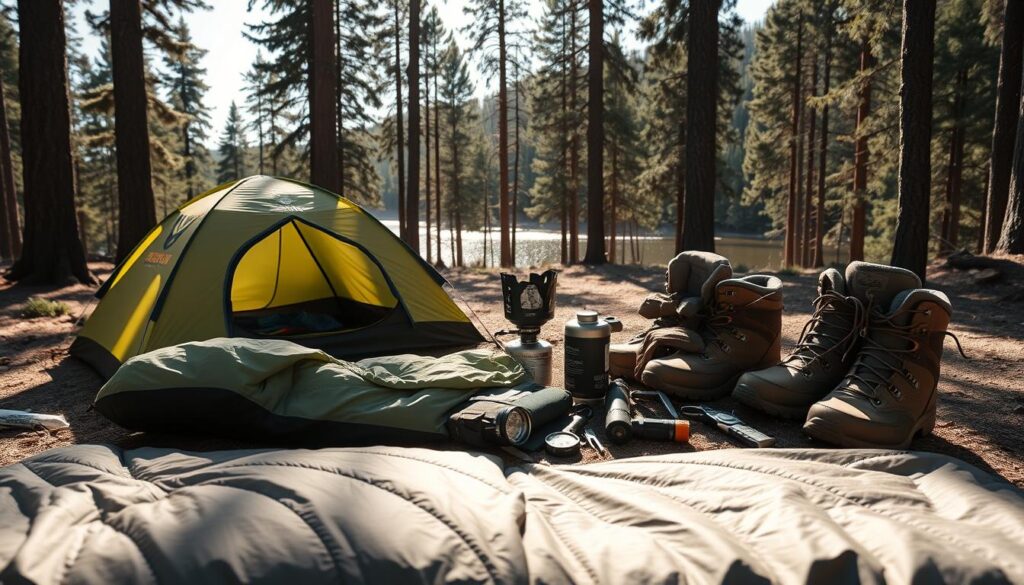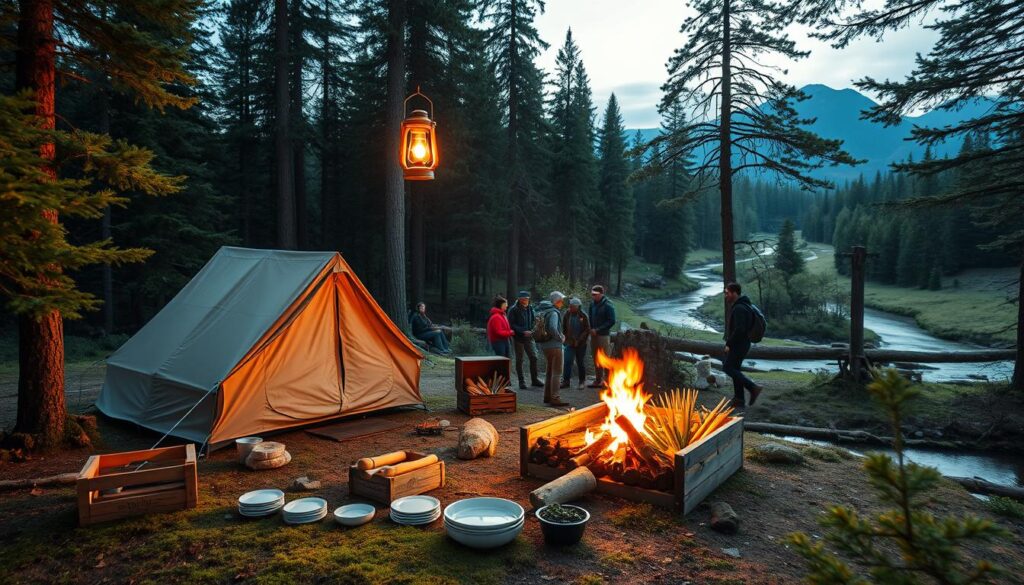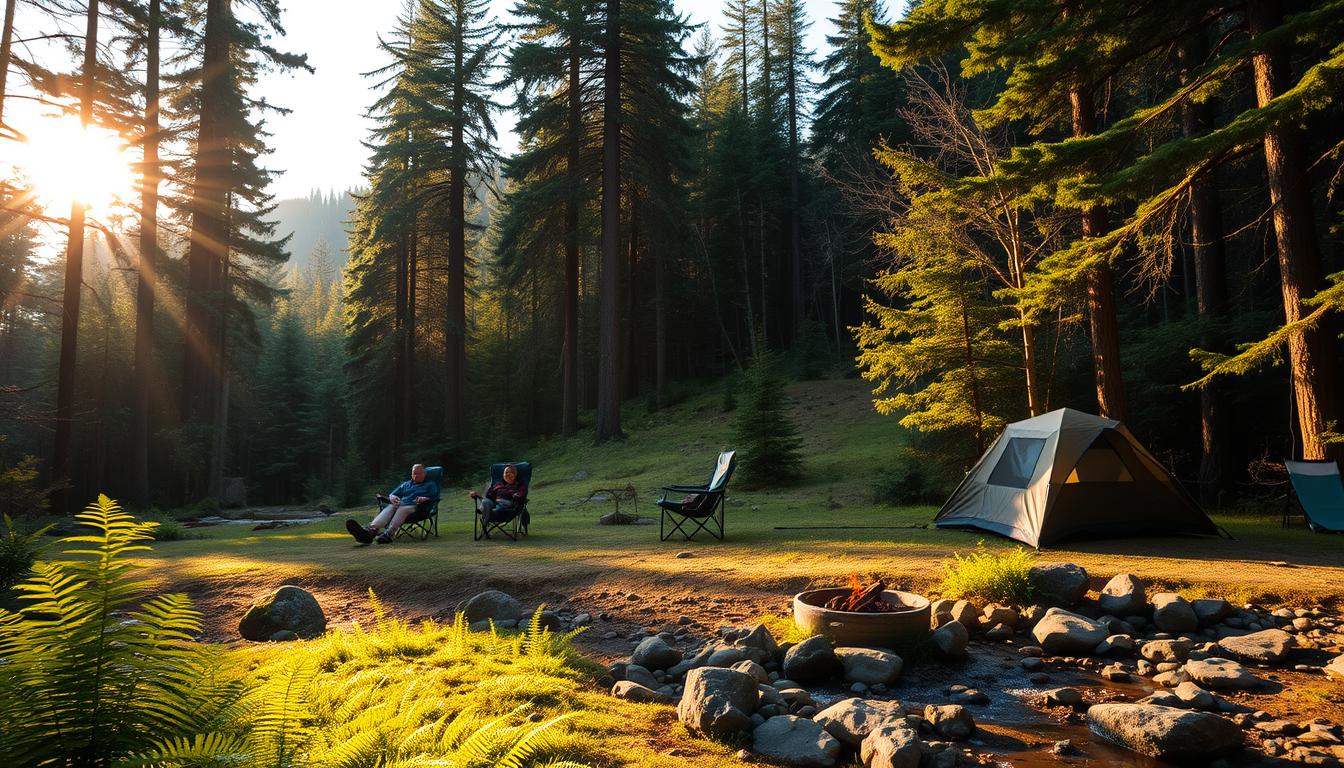Imagine leaving the hustle and bustle behind and immersing yourself in the tranquility of nature. An outdoor camping adventure awaits those who dare to escape into the woods, where the air is fresh, and the sounds of wildlife create a soothing melody.
Camping in the woods offers a unique opportunity to reconnect with the natural world. As you settle into your campsite, the stresses of daily life begin to fade, replaced by the simple joys of s’mores, campfires, and stargazing.
Key Takeaways
- Discover the serenity of nature through camping.
- Experience the thrill of outdoor adventures.
- Learn how to prepare for a safe and enjoyable trip.
- Explore the best practices for camping in the woods.
- Find out how to make the most of your outdoor experience.
The Magic of Forest Camping
The great outdoors beckons with the promise of adventure and tranquility. Forest camping, in particular, offers a unique blend of excitement and relaxation, making it an attractive getaway for nature lovers and adventure seekers alike.
The Unique Appeal of Woodland Environments
Woodland environments have a captivating effect on many outdoor enthusiasts. The serene beauty of the forest, with its towering trees, vibrant flora, and diverse wildlife, creates an immersive experience that is both calming and exhilarating. Forest camping tips often emphasize the importance of embracing the natural world, leaving behind the distractions of modern life to reconnect with the earth and its rhythms.
As you venture into the woods, the tranquility of the forest surroundings can be a balm to the soul, offering a much-needed respite from the stresses of daily life. The unique appeal of these environments lies in their ability to inspire a sense of wonder and awe, encouraging campers to explore, discover, and appreciate the beauty of nature.
Mental and Physical Benefits of Forest Immersion
Immersing oneself in the forest environment has been shown to have numerous mental and physical benefits. The peaceful atmosphere and natural beauty of the woods can help reduce stress levels, improve mood, and even lower blood pressure. Moreover, engaging in outdoor activities such as hiking, foraging, or simply exploring the surroundings can enhance physical well-being and promote a sense of vitality.
By incorporating wilderness camping essentials into your trip, such as appropriate gear and safety precautions, you can fully enjoy the benefits of forest immersion. As you breathe in the fresh air, listen to the sounds of nature, and bask in the warmth of the campfire, you’ll find that the experience leaves you feeling refreshed, renewed, and more connected to the natural world.
Planning Your Woodland Camping Adventure
A successful woodland camping trip begins with thorough planning and preparation. Whether you’re a seasoned camper or just starting out, understanding the key elements of a woodland camping adventure can make all the difference in your experience.
Selecting the Best Season for Forest Camping
The best season for forest camping depends on your preferences and the activities you have planned. Spring and fall are often considered ideal due to the mild temperatures and fewer insects. However, if you’re looking for a winter wonderland experience or summer hiking opportunities, each season has its unique charms.
Researching Camping Regulations and Permits
Before heading out, it’s crucial to research the camping regulations and permits required for your chosen location. Different campsites have varying rules regarding campfires, waste disposal, and quiet hours. Understanding these regulations will help you prepare and avoid any potential fines or issues during your trip.
| Regulation | Description | Importance |
|---|---|---|
| Campfire Restrictions | Rules regarding when and where campfires are allowed | High |
| Waste Disposal | Guidelines for disposing of trash and human waste | High |
| Quiet Hours | Times when noise levels should be kept to a minimum | Medium |
Setting Realistic Expectations and Goals
Setting realistic expectations and goals for your trip is vital. Consider the length of your trip, your physical abilities, and what you hope to achieve or experience during your camping adventure. This will help you plan a more enjoyable and stress-free trip.
By carefully planning your woodland camping adventure, you can ensure a memorable and enjoyable experience. From selecting the best season to understanding camping regulations and setting realistic goals, every step counts.
Finding the Perfect Camping in Woods Location
With numerous options available, identifying the perfect woodland camping location requires some research. The United States offers a diverse range of camping environments, from the dense forests of the Pacific Northwest to the deciduous woods of the Northeast.
National Forests vs. State Parks vs. Private Campgrounds
When it comes to camping in the woods, you have several options to consider. National Forests offer vast, undeveloped areas with dispersed camping opportunities, ideal for those seeking solitude. State Parks, on the other hand, provide more amenities and often have designated campsites. Private Campgrounds can offer a balance between the two, with various amenities and services available.
Each option has its advantages. National Forests are generally less crowded and offer a more primitive experience. State Parks provide access to amenities like picnic areas and hiking trails. Private Campgrounds often have amenities like showers and laundry facilities.
Top Woodland Camping Destinations in America
Some of the top woodland camping destinations in America include the Adirondack Park in New York, the Great Smoky Mountains in Tennessee and North Carolina, and the Olympic National Forest in Washington State. These locations offer a mix of scenic beauty, diverse wildlife, and recreational activities.
How to Evaluate Campsite Features and Amenities
When evaluating a campsite, consider factors like proximity to water sources, availability of picnic tables and fire pits, and access to hiking trails. It’s also essential to assess the campsite’s environmental impact and adhere to eco-friendly camping practices to minimize your footprint.
By carefully selecting your camping location and being mindful of camping safety in forests, you can ensure a enjoyable and safe woodland camping experience.
Essential Gear for Woodland Camping
When venturing into the woods, having the essential camping gear is crucial for a comfortable experience. The right equipment can make a significant difference in your woodland camping adventure, ensuring you’re prepared for the challenges of the wilderness.
Shelter Options for Forest Environments
Choosing the right shelter is vital for protection against the elements. Your options include tents, hammocks, and tarps, each with its own advantages.
Tents vs. Hammocks vs. Tarps
Tents offer comprehensive protection and are easy to set up. Hammocks provide a unique sleeping experience and are ideal for areas with suitable tree spacing. Tarps are lightweight and versatile, offering flexible shelter configurations.
Weather Considerations for Shelter Selection
Consider the weather forecast and potential environmental conditions when selecting your shelter. For instance, tents are generally better for harsh weather, while hammocks are suitable for fair conditions.

Sleeping Systems for Comfort in the Woods
A good night’s sleep is essential for enjoying your camping trip. This involves not just a shelter, but also a comfortable sleeping bag and pad.
- Choose a sleeping bag rated for the expected low temperatures.
- Use a sleeping pad for insulation and comfort.
Cooking Equipment for Campfire Meals
Cooking in the woods can be a delightful experience with the right equipment. Consider a portable stove or camping grill for meal preparation.
| Cooking Method | Equipment Needed | Advantages |
|---|---|---|
| Campfire Cooking | Grill, cooking pot, utensils | Traditional camping experience, versatile |
| Portable Stove | Stove, fuel, cooking pot | Easy to use, quick heating |
Tools and Miscellaneous Items for Forest Camping
Other essential items include a first aid kit, navigation tools, and a multi-tool or pocket knife. Don’t forget to pack appropriate clothing and personal hygiene items.
By carefully selecting your camping gear for wooded areas, you can ensure a safe, enjoyable, and memorable wilderness camping experience.
Clothing and Personal Items for Forest Environments
The key to a comfortable and enjoyable forest camping experience lies in your choice of clothing and personal gear. When venturing into the woods, it’s essential to be prepared for varying weather conditions and challenging terrain.
Dressing for Woodland Weather Conditions
Dressing in layers is a crucial strategy for managing body temperature in the forest. Start with a moisture-wicking base layer, add an insulating mid-layer, and finish with a waterproof outer layer. This approach allows you to adjust your clothing according to the weather.
Weather-appropriate clothing includes a hat, gloves, and a scarf for colder conditions, as well as breathable fabrics for warmer days. Always check the weather forecast before your trip to ensure you’re prepared.
Selecting Appropriate Footwear for Forest Terrain
Choosing the right footwear is vital for a successful camping trip. Sturdy hiking boots or trail shoes with good tread and ankle support are ideal for navigating forest terrain. Consider the terrain and weather conditions when selecting your footwear.
Personal Hygiene and First Aid in the Wilderness
Maintaining personal hygiene is important for health and comfort during your camping trip. Pack biodegradable soap and toilet paper for personal hygiene. A first aid kit is also essential, including items like bandages, antiseptic wipes, and pain relievers.
| Item | Purpose | Recommendation |
|---|---|---|
| Moisture-wicking base layer | Temperature regulation | Choose synthetic or merino wool |
| Hiking boots | Foot protection and support | Select waterproof boots with good tread |
| Biodegradable soap | Personal hygiene | Use sparingly and away from water sources |
| First aid kit | Treat minor injuries | Include bandages, antiseptic wipes, and pain relievers |
Setting Up Your Woodland Campsite
The key to a successful woodland camping trip lies in choosing and setting up the perfect campsite. A well-organized campsite not only enhances your camping experience but also ensures your safety within the forest environment.
Choosing the Ideal Tent Location
When selecting a spot for your tent, look for a flat area that is well-drained and protected from the elements. Avoid low-lying areas that may flood during rain. Consider the natural surroundings to minimize your impact on the environment.
Creating a Functional Camp Layout
A functional camp layout is crucial for efficiency and comfort. Designate areas for cooking, sleeping, and relaxation. Ensure that your campfire area is safely distanced from your tent and other flammable materials.
Establishing a Safe Fire Pit Area
Building a campfire is a significant aspect of the camping experience. When establishing a fire pit area, choose a location that is away from trees, tents, and other flammable objects.
Fire Building Techniques for Wooded Areas
Use dry, seasoned wood for a sustainable and efficient fire. Start with tinder, followed by kindling, and gradually add larger logs. Ensure that your fire is fully extinguished before leaving it unattended.
Fire Safety and Regulations
Always check local fire safety regulations before building a campfire. Keep a bucket of water or a fire extinguisher nearby to handle any unexpected flare-ups.

By following these guidelines, you can create a safe and enjoyable woodland campsite that complements the natural beauty of the forest.
Forest Camping Safety Essentials
Forest camping safety is paramount, and understanding the essentials can make all the difference in your wilderness adventure. When camping in the woods, it’s crucial to be aware of your surroundings and take necessary precautions to ensure a safe and enjoyable experience.
Wildlife Awareness and Precautions
One of the primary concerns when camping in the forest is wildlife encounters. Being aware of the types of animals in the area and taking steps to prevent encounters is vital.
Bear Safety Protocols
When camping in bear country, it’s essential to follow bear safety protocols, such as storing food and trash properly and being mindful of your surroundings.
Dealing with Smaller Forest Creatures
Smaller creatures like snakes, spiders, and rodents can also pose a threat. Knowing how to react in case of an encounter and taking preventive measures can minimize risks.
Weather Safety in Wooded Areas
Weather conditions can change rapidly in wooded areas, and being prepared is crucial. Understanding how to read weather signs and having a plan for severe weather can help ensure your safety.
Navigation and Preventing Getting Lost
Getting lost in the woods can be a frightening experience. Knowing how to navigate using a map, compass, and GPS device, and having a plan for emergency situations, can help prevent getting lost.
| Safety Concern | Precaution | Emergency Response |
|---|---|---|
| Wildlife Encounters | Store food and trash properly, make noise while hiking | Remain calm, back away slowly, do not run |
| Severe Weather | Monitor weather forecasts, seek shelter | Seek immediate shelter, avoid being near tall objects |
| Getting Lost | Carry a map, compass, and GPS device, let someone know your itinerary | Stay calm, stay put, use signaling devices to alert rescuers |
By being aware of potential safety concerns and taking necessary precautions, you can ensure a safe and enjoyable forest camping experience.
Sustainable Camping Practices in Forest Environments
Sustainable camping practices are crucial for maintaining the health and integrity of forest ecosystems. As more people seek to escape to nature, the importance of adopting eco-friendly camping practices cannot be overstated.
Leave No Trace Principles for Woodland Camping
The Leave No Trace principles provide a framework for minimizing our impact on the environment. These principles include planning ahead, staying on designated trails, and disposing of waste properly. By following these guidelines, campers can significantly reduce their ecological footprint.
- Plan ahead and prepare
- Travel and camp on durable surfaces
- Dispose of waste properly
- Leave what you find
- Minimize campfire impacts
- Respect wildlife
- Be considerate of other visitors
Minimizing Your Environmental Impact
Minimizing environmental impact requires a thoughtful approach to camping. This includes being mindful of waste disposal and respecting wildlife habitats.
Proper Waste Disposal
Proper waste disposal is critical to maintaining the cleanliness and health of forest environments. Campers should pack out all trash and disposable items, leaving the campsite in the same condition as it was found.
Respecting Plant and Wildlife Habitats
Respecting plant and wildlife habitats is essential for preserving biodiversity. Campers should avoid damaging vegetation and disturbing wildlife, keeping a safe distance and not feeding animals.
| Best Practices | Environmental Benefit |
|---|---|
| Proper waste disposal | Reduces pollution and maintains soil and water quality |
| Respecting wildlife habitats | Preserves biodiversity and maintains ecosystem balance |
| Using eco-friendly camping gear | Reduces carbon footprint and supports sustainable manufacturing |

Activities to Enhance Your Woodland Camping Experience
Woodland camping offers a unique blend of adventure and tranquility, waiting to be explored. To make the most of your outdoor camping adventure, engaging in various activities can significantly enhance your experience.
Forest Hiking and Nature Observation
One of the joys of woodland camping is the opportunity to explore the surrounding forests through hiking. Trails range from easy strolls to challenging hikes, offering something for every adventurer. As you hike, take time for nature observation, noting the diverse flora and fauna that inhabit the woods. This connection with nature can be profoundly rejuvenating.
Foraging and Wild Edibles (with Caution)
Foraging for wild edibles can be a rewarding experience, allowing you to sample the natural bounty of the forest. However, it’s crucial to exercise caution and only consume plants you can positively identify as safe. Never eat anything you’re unsure about, as some plants can be toxic. With proper knowledge and care, foraging can add a delicious dimension to your camping experience.
Night Activities in the Woods
As night falls, the woods transform, offering a new set of experiences. Two particularly enjoyable activities are stargazing and nighttime wildlife watching.
Stargazing in Forest Clearings
Find a clearing away from trees, and you’ll be treated to a spectacular night sky. The lack of light pollution in woodland areas makes for incredible stargazing opportunities. Lie back, relax, and let the stars twinkle above you.
Nighttime Wildlife Watching
Some wildlife is more active at night, offering a chance to observe creatures under the cover of darkness. Keep quiet and stay alert, and you might catch a glimpse of nocturnal animals going about their business.
| Activity | Best Time | Tips |
|---|---|---|
| Forest Hiking | Daytime | Wear comfortable shoes and stay hydrated. |
| Foraging | Daytime | Be sure of what you’re eating; consult a guide. |
| Stargazing | Nighttime | Find a clearing away from trees and light. |
By incorporating these activities into your woodland camping trip, you’ll not only enhance your experience but also create lasting memories of your time in the great outdoors.
Conclusion: Embracing the Forest Camping Lifestyle
Camping in woods offers a unique opportunity to disconnect from the hustle and bustle of daily life and reconnect with nature. By following forest camping tips, you can ensure a safe and enjoyable experience.
As you’ve learned, forest camping requires careful planning, preparation, and attention to sustainable practices. By embracing these principles, you can minimize your impact on the environment and maximize your connection with the natural world.
Whether you’re a seasoned camper or just starting out, the forest camping lifestyle has something to offer everyone. So pack your gear, grab your loved ones, and head into the woods to experience the magic of forest camping for yourself.
By adopting the practices and principles outlined in this article, you’ll be well on your way to becoming a responsible and seasoned forest camper, ready to take on new adventures and create lasting memories in the great outdoors.

